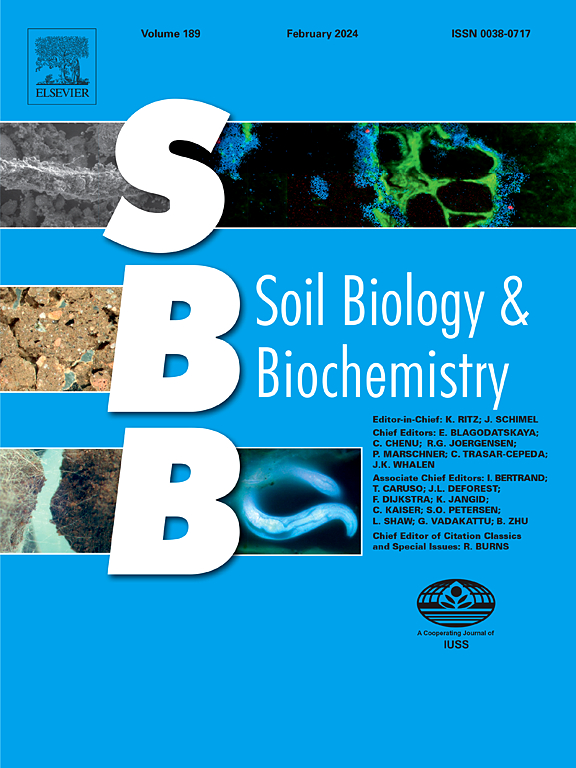Differences between priming and rhizosphere priming effects: Concepts and mechanisms
IF 10.3
1区 农林科学
Q1 SOIL SCIENCE
引用次数: 0
Abstract
The addition of fresh carbon (C) substrates to the soil can result either in the acceleration or retardation of native soil organic matter (SOM) decomposition, referred to as the priming effect (PE). Related to PE is the rhizosphere priming effect (RPE), which involves the activity of plant roots. It remains unclear whether PE and RPE differ in their impacts on soil C dynamics and their response to soil nitrogen (N) availability. Here, we highlight drivers and mechanisms that distinguish RPE from PE and how they change with N addition. We develop different scenarios for PE and RPE separately and their responses to N addition. We describe temporal differences between PE and RPE, where microbes become more C limited with time in PE studies and more N limited in RPE studies. We then analysed published data to assess support for our scenarios. Without N addition PE and RPE were mostly positive and of similar magnitude, indicating that stoichiometric decomposition under microbial C limitation and N mining under microbial N limitation are major drivers of PE and RPE. Root effects on physical and chemical destabilization of native SOM and plant-microbe competition for N may also cause positive RPEs. With N addition, more than half of all observations showed reductions in PE (56%) and RPE (51%), possibly because of N-induced soil acidification. The RPEs and their responses to N could potentially last longer than for PE, due to ongoing root-induced destabilization of SOM and competition for N between plants and microbes thereby maintaining microbial N limitation and N mining. The distinctly different mechanisms and temporal dynamics between PE and RPE will have important implications for short- and long-term SOM dynamics and their responses to N addition.
启动和根际启动效应的差异:概念和机制
向土壤中添加新鲜碳(C)基质可以加速或延缓土壤有机质(SOM)的分解,这被称为启动效应(PE)。与PE相关的是根际启动效应(RPE),它涉及植物根系的活动。PE和RPE对土壤碳动态的影响及其对土壤氮有效性的响应是否存在差异尚不清楚。在这里,我们强调了区分RPE和PE的驱动因素和机制,以及它们如何随着N的增加而变化。我们分别开发了PE和RPE对N添加的响应。我们描述了PE和RPE之间的时间差异,在PE研究中,微生物随着时间的推移越来越受C限制,而在RPE研究中,微生物越来越受N限制。然后,我们分析了已发表的数据,以评估对我们设想的支持。未添加N时,PE和RPE多为正,且值相近,说明微生物C限制下的化学计量分解和微生物N限制下的N开采是PE和RPE的主要驱动因素。根系对天然SOM的物理和化学不稳定性的影响以及植物-微生物对N的竞争也可能导致RPEs为正。在添加氮的情况下,超过一半的观测结果显示PE(56%)和RPE(51%)的降低,这可能是由于氮引起的土壤酸化。rpe及其对N的响应可能比PE持续更长时间,这是由于根系诱导的SOM不稳定以及植物和微生物之间对N的竞争,从而维持微生物对N的限制和对N的挖掘。PE和RPE之间明显不同的机制和时间动态将对SOM的短期和长期动态及其对N添加的响应产生重要影响。
本文章由计算机程序翻译,如有差异,请以英文原文为准。
求助全文
约1分钟内获得全文
求助全文
来源期刊

Soil Biology & Biochemistry
农林科学-土壤科学
CiteScore
16.90
自引率
9.30%
发文量
312
审稿时长
49 days
期刊介绍:
Soil Biology & Biochemistry publishes original research articles of international significance focusing on biological processes in soil and their applications to soil and environmental quality. Major topics include the ecology and biochemical processes of soil organisms, their effects on the environment, and interactions with plants. The journal also welcomes state-of-the-art reviews and discussions on contemporary research in soil biology and biochemistry.
 求助内容:
求助内容: 应助结果提醒方式:
应助结果提醒方式:


